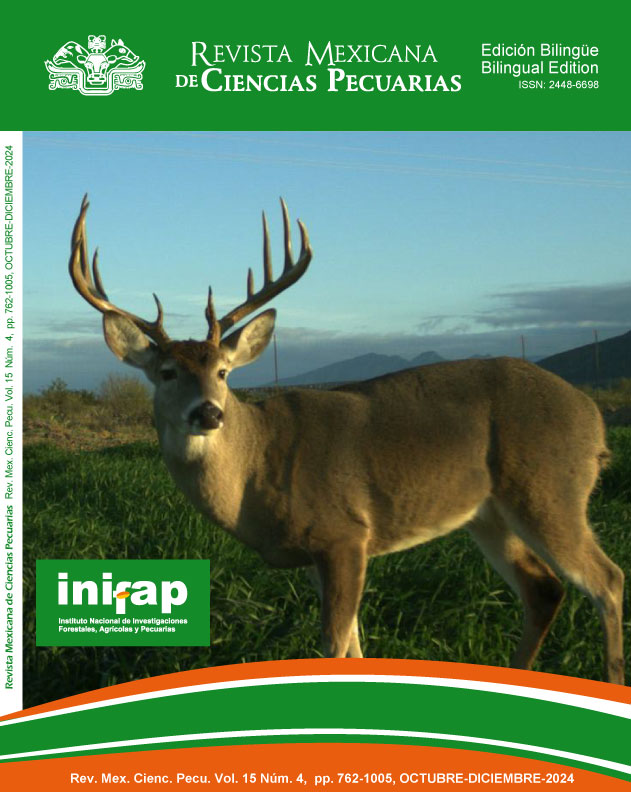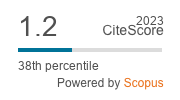The management of irrigated elephant grass intercropped with legumes in the semi-arid region
DOI:
https://doi.org/10.22319/rmcp.v15i4.6758Palabras clave:
Cajanus;, stylo, grass, forage massResumen
The present study aimed to evaluate the production and chemical composition of elephant grass (Pennisetum purpureum syn. Cenchrus purpureus cv. Mott) intercropped with Cajanus cajan (Mandarim and Fava Larga) and Stylosanthes guianensis (Bela) compared to its cultivation in monoculture under irrigated management in the semi-arid region. The experiment was conducted at the Campus of Agricultural Sciences of the Federal University of the São Francisco Valley, Petrolina, Brazil. The experiment consisted of the following treatments: elephant grass intercropped with each legume and two monoculture types, one with nitrogen fertilization (200 kg ha-1) and the other without. The legumes helped to improve the quality of the forage canopy, with high levels of crude protein. Nitrogen fertilization increased the mass of forage produced by elephant grass. The cumulative analysis of all the cuts showed that the intercropping between elephant grass and the Bela cultivar achieved the highest yield, with 13.49 Mg ha-1, mainly due to the increase in the population of the Bela, which proved to be superior to the other legumes over the cuts. Based on the results, the intercropping of elephant grass with the Bela cultivar is recommended as the most effective strategy for maximizing forage production in the semi-arid region.
Descargas
Citas
Pereira GF, Emerenciano Neto JV, Difante GS, Assis LCS, Lima PO. Morphogenic and structural characteristics of tropical forage grasses managed under different regrowth periods in the Brazilian semi-arid region. Semina: Ciênc Agrár 2019;40(1):283.
Costa ABG, Difante GS, Campelo BAM, Gurgel ALC, Costa CM, Theodoro GF, et al. Morphogenetic, structural and production traits of Marandu grass under nitrogen rates in Neo soil. Arq Bras Med Vet Zootec 2021;73:658-664.
Oliveira LE, Oliveira FH, Silva GG, Bezerra MGS, Morais ÉG, Bezerra GF, et al. Nitrogen and phosphorus fertilizer application to Elephant grass (Cenchrus purpureus syn. Pennisetum purpureum) cultivar ‘Cameroon’ in an arenosol in Rio Grande do Norte, Brazil. Trop Grassl Forrajes Trop 2022;10(3):280-287.
Figueiredo MRP, Teixeira ACB, Bittencourt LL, Moreira GR, Ribeiro AJ, Silva FSG, et al. Elephant grass silage with addition of regional by-products. Acta Sci Anim Sci 2022;44.
Islam MR, Garcia SC, Islam MA, Bashar MK, Roy A, Roy BK, Sarker NR, Clark CEF. Ruminant production from napier grass (Pennisetum purpureum Schum): A review. Animals (Basel) 2024;14:467.
Bueno AM, Andrade AF, Viçosi KA, Flores RA, Sette CR, Cunha TQG, Santos GG. Does nitrogen application improve elephant grass yield and energetic characteristics of biofuels? Bioenerg Res 2021;14:774-784.
Boddey RM, Casagrande DR, Homem BGC, Alves BJR. Forage legumes in grass pastures in tropical Brazil and likely impacts on greenhouse gas emissions: A review. Grass Forage Sci 2020;75:1-15.
Rezende PR, Rodrigues LM, Backes C, Teodoro AG, Santos AJM, Fernandes PB, Giongo PR, Ribon AA, Bessa SV. Productivity and nutrient extraction by Paiaguás palisadegrass submitted to doses of nitrogen in single cultivation and intercropped with pigeon pea. Arq Bras Med Vet Zootec 2022;74:1151-1160.
Epifanio PS, Costa KAP, Severiano EC, Souza WF, Teixeira DAA, Silva JT, Aquino MM. Productive and nutritional characteristics of Brachiaria brizantha cultivars intercropped with Stylosanthes cv. Campo Grande in different forage systems. Crop Pasture Sci 2019;70:718-729.
Santos HG, Jacomine PKT, Anjos LHC, Oliveira VA, Lumbrera JF, Coelho MR, et al. Sistema brasileiro de classificação de solos. 5th ed. Brasília: Embrapa CNPS; 2018.
Detmann E, Souza MA, Valadares Filho SC. Métodos para análise de alimentos – INCT - Ciência animal. Visconde do Rio Branco: Suprema; 2012.
Bates D, Mächler M, Bolker B, Walker S. Fitting linear mixed-Effects models using lme4. J Stat Softw 2015;67:1-48.
Lenth R, Singmann H, Love J, Buerkner P, Herve M. Emmeans: estimated marginal means, aka least-squares means. R Package Version 1.4.8. Retrieved from https://CRAN.R-project.org/package=emmeans.
R Core Team. R: A Language and Environment for Statistical Computing. Retrieved from https://www.R-project.org/.
Silva PH, Santos MV, Mello AC, Silva TBS, Neto DES, da Silva VJ, Dubeux Jr JCB, Coelho JJ, Souza EJO, Cunha MV. Agronomic responses and herbage nutritive value of elephant grass (Cenchrus purpureus) genotypes grown as monocrops and mixed with butterfly pea (Clitoria ternatea). Crop Pasture Sci 2023;74:1210-1222.
Seibt DC, Olivo CJ, Alessio V, Sauter CP, Bratz VF, Aguirre PF. Forage mass and nutritional value of elephant grass intercropped with forage legumes. Rev Ceres 2021;68:429-440.
Fernandes PB, Barbosa RA, Morais MG, Medeiros-Neto C, Gurgel ALC, Costa CM, Costa ABG, Santana JCS, Silva MGP, Difante GS. Evaluation and reparametrization of mathematical models for prediction of the leaf area of Megathyrsus maximus cv. BRS Zuri. Trop Grassl Forrajes Trop 2020;8:214-219.
Euclides VPB, Montagner DB, Araújo AR, Pereira MA, Difante GS, Araújo IMM, Barbosa LF, Barbosa RA, Gurgel ALC. Biological and economic responses to increasing nitrogen rates in Mombaça guinea grass pastures. Sci Rep 2022;12:1937.
Rodrigues LF, Santos AC, Junior OS, Santos JGD, Faria AFG, Coelho BPL. Morphogenic and structural characteristics of Marandu grass cultivated under grazing management and nitrogen fertilization. Semina: Ciênc Agrár 2019;40(5Supl1):2331-2340.
Lemaire G, Agnusdei M. Leaf tissue turn-over and efficiency of herbage utilization. In: Lemaire G, Hodgson J, Moraes A, et al. editors. Grassland ecophysiology and grazing ecology. Wallingford: CAB International; 2000:265-288.
Difante GS, Nascimento Junior DD, Da Silva SC, Euclides VPB, Montagner DB, Silveira MCT, Pena KS. Características morfogênicas e estruturais do capim-marandu submetido a combinações de alturas e intervalos de corte. Rev Bras Zootec 2011;40:955-963.
Sales ECJ, Saraiva CRS, Reis ST, Rocha Júnior VR, Pires DAA, Vitor CMT. Morphogenesis and productivity of Pioneiro elephant grass under different residual heights and light interceptions. Acta Sci Anim Sci 2014;36:137-143.
Chapagain T, Riseman A. Intercropping wheat and beans: effects on agronomic performance and land productivity. Crop Sci 2014;54:2285-2293.
Menezes RC, Alves EB, Casagrande DR, Lara MAS, Evangelista AR, Bernardes TF. Xaraés palisadegrass remains productive after the disappearance of stylo in tropical legume-grass pasture. Sci Agric 2015;72(6):484-488.
Ferreira EA, Abreu JG, Martinez JC, Braz TGS, Ferreira DP. Cutting ages of elephant grass for chopped hay production. Pesqui Agropecu Trop 2018;48(3):245-253.
Coca FOCG, Gomes ENO, Junges L, Itavo LCV, Nonato LM, Gomes FK, Itavo CCBF, Difante GS, Dias AM. Protodioscin content, degradation kinetics, and in vitro digestibility of Marandu palisadegrass hay as were affected by cutting interval of the canopy. Trop Anim Sci J 2022;45:299-307.
Euclides VPB, Macedo MCM, Valle CBD, Difante GDS, Barbosa RA, Cacere ER. Valor nutritivo da forragem e produção animal em pastagens de Brachiaria brizantha. Pesqui Agropecu Bras 2009;44:98-106.
Rodrigues JG, Difante GS, Ítavo LCV, Pereira MG, Gurgel ALC, Costa ABG, Véras ELL, Monteiro GOA, Dias AM, Ítavo CCBF. Forage Accumulation and Nutritional Characteristics of Brachiaria Cultivars Grown in a Semi-arid Environment. Trop Anim Sci J 2023;46:85-96.
Costa RRGF, Costa KAP, Souza WF, Epifanio PS, Santos CB, Silva JT, Oliveira SS. Production and quality of silages pearl millet and paiaguas palisadegrass in monocropping and intercropping in different forage systems. Biosci J 2018;34:957-967.
Brâncio PA, Euclides VPB, Nascimento Júnior D, Fonseca DM, Almeida RG, Macedo MCM, Barbosa RA. Avaliação de três cultivares de Panicum maximum Jacq. sob pastejo: disponibilidade de forragem, altura do resíduo pós-pastejo e participação de folhas, colmos e material morto. Rev Bras Zootec 2003;32:55-63.
Lima ES, Silva JFC, Vásquez HM, Araújo SAC, Lista FN, Costa DPB. Produção de matéria seca e proteína bruta e relação folha/colmo de genótipos de capim-elefante aos 56 dias de rebrota. Rev Bras Zootec 2007;36:1518-1523.
Ligoski B, Gonçalves LF, Claudio FL, Alves EM, Krüger AM, Bizzuti BE, Lima PMT, Abdalla AL, Paim TP. Silage of intercropping corn, palisade grass, and pigeon pea increases protein content and reduces in vitro methane production. Agronomy 2020;10:1784.
Prado LG, Costa KAP, Silva LM, Costa AC, Severiano EC, Costa JVCP, Habermann E, Silva JAG. Silages of sorghum, Tamani guinea grass, and Stylosanthes in an integrated system: production and quality. Front Sustain Food Syst 2023;7:1-15.
Silva LM, Costa KAP, Oliveira KJ, Costa AC, Silva JAG, Costa JVCP, et al. Fermentation dynamics and quality of maize silage with Pigeon pea. Sem Ci Agr 2023;44:567-584.
Descargas
Publicado
Cómo citar
-
Resumen99
-
PDF6
-
PDF 7
-
Texto completo5
-
Full text 5
Número
Sección
Licencia

Esta obra está bajo una licencia internacional Creative Commons Atribución-NoComercial-CompartirIgual 4.0.
Los autores/as que publiquen en la Revista Mexicana de Ciencias Pecuarias aceptan las siguientes condiciones:
De acuerdo con la legislación de derechos de autor, la Revista Mexicana de Ciencias Pecuarias reconoce y respeta el derecho moral de los autores/as, así como la titularidad del derecho patrimonial, el cual será cedido a la revista para su difusión en acceso abierto.

Esta obra está bajo una Licencia Creative Commons Atribución-NoComercial-CompartirIgual 4.0 Internacional.





